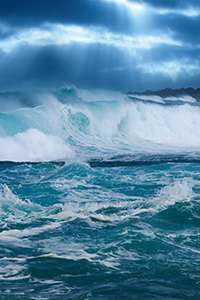How sea spray particles evolve in the atmosphere

When ocean waves make bursting whitecaps or crash against the shores, tiny particles of sea spray enter the atmosphere. Once airborne, the particles are quickly coated by carbon-rich or organic chemicals. The carbon-rich chemicals, emitted by diverse human-made and natural sources, cause the particles to evolve, according to scientists at Lawrence Berkeley National Laboratory (LBNL) and Pacific Northwest National Laboratory (PNNL). Using complementary chemical imaging techniques, the team found that when temperature and humidity rise, reactions within particles create organic salts. These reacted particles, when chilled, become glass-like lumps.
"This study helps to understand how biogenic emission, as well as industries, transportation, power generation, and other combustion sources can influence the chemistry of the marine aerosols near the oceans," said Dr. Bingbing Wang, a PNNL chemist and first author on the study.
Both nature's plants and industry release chemicals that react with sea salt in coastal areas. Writing policies to manage the resulting particles will benefit from accurate models of atmospheric processes, such as particle-cloud interactions. This study provides insights for the models as to the constituents and structure of key particles. The study's results will make computational models more accurate and help in designing effective ways to mitigate and adapt to atmospheric changes.
"The reactions that occur are, in a way, counterintuitive. If you did similar reactions in a beaker, you wouldn't see these reactions take place," said Dr. Alexander Laskin, a PNNL chemist who led the study. "But in the tiny particles, the thermodynamic rules are somewhat different allowing the reactions to proceed."
As part of a decade-long collaboration, the team examined the internal morphology and chemical identity of atmospheric particles from various sources. Using highly complementary scientific approaches, they obtained chemical images of the particles with nanometer resolution. They characterized the different chemicals using X-ray microspectroscopy. This instrument showed the distribution of different chemicals inside the particles. The instrument is available at the Department of Energy's (DOE's) Advanced Light Source, a national scientific user facility.
Also, they used a computer-controlled electron microscope to analyze the structure and elemental composition of thousands of particles quickly. This technique provided the statistical depth or large sample data needed for the study. They used other characterization techniques as well, including micro-Fourier-transform infrared spectrometer and Nanospray Desorption Electrospray Ionization with high-resolution mass spectrometry. These instruments are located at DOE's EMSL, a national scientific user facility.
"Any technique on its own would not be sufficient to describe the reactions in the particle," said Laskin. "Using DOE resources, we unraveled that complexity."
Using the data, Wang led modeling and calculations, showing that the particle react with each other and become depleted in chloride when the particles are in a liquid-like condensed phase. The higher the amount of organic chemicals in the particle, the greater the loss of chloride. The chloride is lost as gaseous hydrochloric acid. The particle's viscosity, or stickiness, temperature, time, relative humidity, and amount of carbon-rich chemicals, among other factors, influences the extent of the reactions. Further, the reactions form organic salts.
"The formation of these organic salts can alter particles' properties and may affect their ability to act as 'seeds' for clouds. The release of hydrochloric acid—and its potential recycling back into the particles—may have important implications for atmospheric chemistry," said Wang.
Now, the team is developing the needed capabilities to examine the particles as they evolve in real time. They are also characterizing the internal reactions at different levels of humidity.
More information: Wang B, RE O'Brien, ST Kelly, JE Shilling, RC Moffet, MK Gilles, and A Laskin. 2014. "Reactivity of Liquid and Semisolid Secondary Organic Carbon with Chloride and Nitrate in Atmospheric Aerosols." Journal of Physical Chemistry A. DOI: 10.1021/jp510336q
Journal information: Journal of Physical Chemistry A
Provided by Pacific Northwest National Laboratory



















